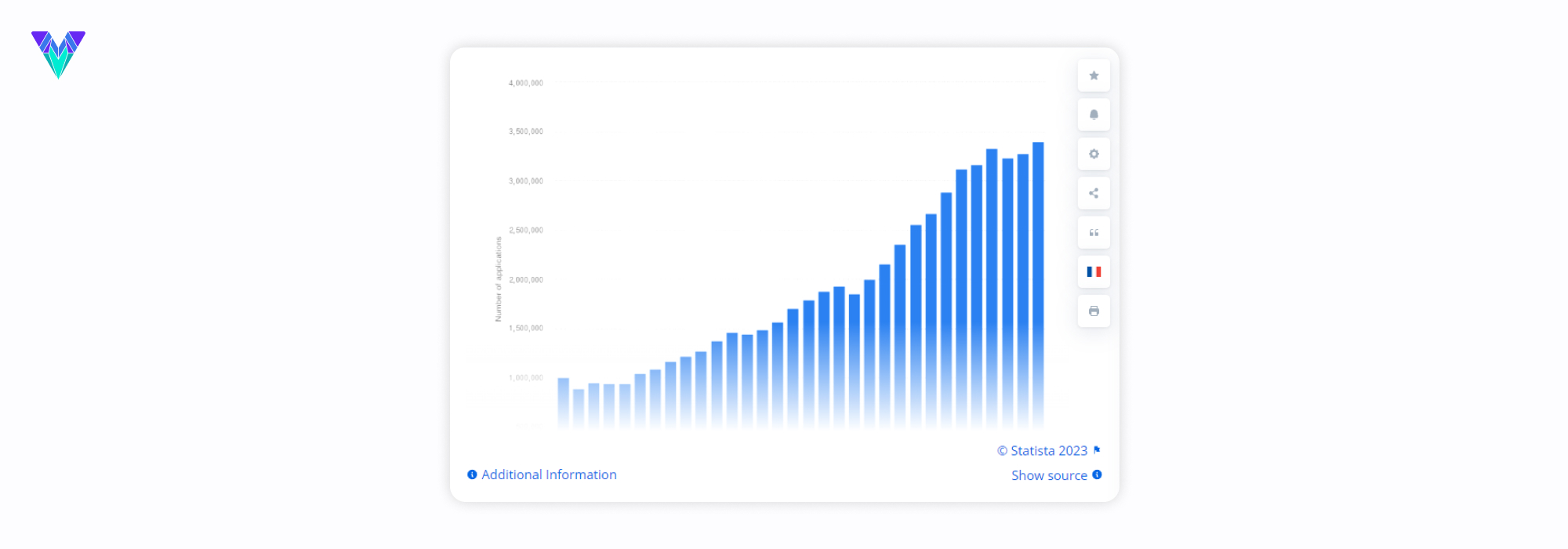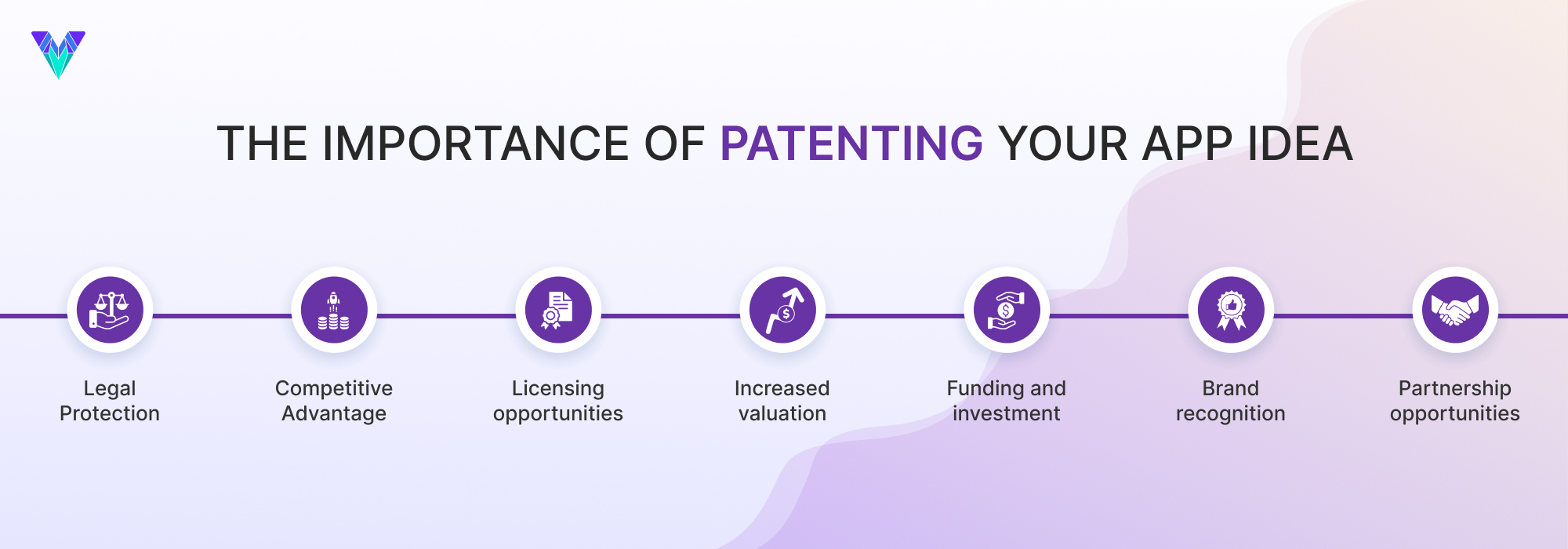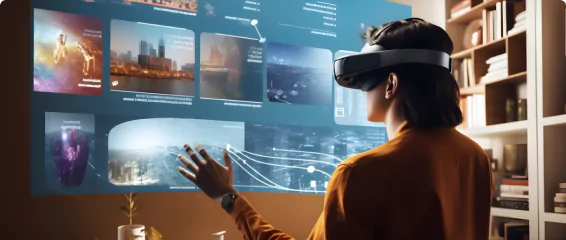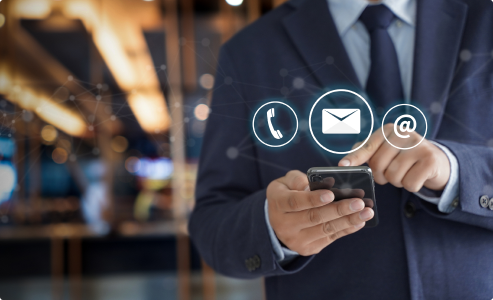Machine Learning and AI for revolution of Tech Companies are changing and streamlining businesses.
Imagine getting an amazing idea for a new app – it’s unique, innovative, and exclusive. Secure your ideas before someone else gets your idea and gets copied.
A patent is a legal document that gives the owner the right to prevent others from using or selling the invention without prior permission. There are different types of patent applications, like utility, design, and plant.
We will discuss further the steps involved in how to patent an idea for an app, the different types of patents available, the legal requirements, and the benefits of patenting your app idea.
What is a patent?
A patent is a legal document that gives the owner extensive rights to use, create and sell an invention for a specific period.

According to Statista, in 2021, there were approximately 3.4 million patent applications worldwide, marking a significant increase from the previous year’s 3.28 million applications. This application surge also represents the highest number of patent applications filed globally in the past three decades.
What are the different types of patent apps?
Here are three types of patent applications
- Utility Patent: protects the functionality.
- Design patent: Protects the ornamental appearance.
- Plant patents: Protects the new varieties of plants that have been asexually reproduced.
The process of patenting an app idea
The process of getting a patent for an app idea involves seven steps, which are explained below:
Conduct a patentability search:
Before you file for a patent application, conduct a thorough search to ensure that your idea is exclusive, new, and is not a splitting image of any existing patents.
File a provisional patent application:
Filing a provisional patent application gives you one year to develop your invention even further. This is the easiest and quick way to secure your app idea and its filing date.
Develop a detailed invention disclosure:
A detailed invention disclosure is a must when filing for the non-Provisional patent application to describe your invention in full detail.
File a non-provisional patent application:
A non-provisional patent application is a formal one that provides legal protection for your invention.
Wait for the patent office to review your application:
After filing for the non-provisional patent application, wait for the patent office to conclude if it meets the desired requirements for a patent.
Respond to any objections or rejections from the patent office:
If, in any case, the patent office raises an objection or rejects your application, you will need to respond to these objections or rejections to continue the process.
Receive a patent or appeal a rejection:
You will receive a patent if your app idea is approved; you can appeal the decision if it is not approved.
Legal requirements for app patenting
Your invention must meet the following legal requirements to patent an app idea.
- Novelty: Your invention must be new and not already disclosed to the public.
- Non-obviousness: Your invention must not be obvious to someone skilled.
- Utility: Your invention must have a practical use.
The importance of patenting your app idea

Why you should patent your app idea, to answer this question, we have listed down the importance and benefits of Patenting your app idea.
- Legal Protection: If your App is patented, it will give you exclusive rights to make, sell and use your innovation and prohibit others from using it.
- Competitive Advantage: Patenting your App can prevent others from copying or using it without prior permission.
- Licensing opportunities: A patent can help you license your invention to others and generate revenue.
- Increased valuation: A patent can increase the value of your App and make it more attractive to investors.
- Funding and investment: A patent can help you secure funding and attract investors interested in your unique, protected idea.
- Brand recognition: A patented app can establish your brand as innovative and forward-thinking.
- Partnership opportunities: A patent can attract partnerships and collaborations with companies interested in your app idea.
App development and patenting
Many wonder if there’s any relation between app development and patenting. Well, App Development and Patenting are related for more than one reason.
In the process of App development, patenting an app idea should be considered as a first step. You can secure your App while developing by conducting a search and filing a provisional patent application.
The patenting process can affect your App’s development by adding additional time and costs. However, it is crucial to prioritize intellectual property protection to secure the long-term success of your App.
Common mistakes when patenting an app idea
There are a few common mistakes people make when they are patenting their App Idea:
- Not conducting a patentability search before filing a patent application.
- Filing a patent application way too early in the development process.
- Not disclosing all relevant information about the invention.
- Failing to respond to objections or rejections from the patent office on time.
However, you can avoid these mistakes by working with a patent attorney who can guide you through the process and prevent you from making mistakes.
Alternatives to patenting an app idea
If you do not want a patent for your app idea, some alternatives can protect your invention from getting stolen. But each method has its benefits and drawbacks.
- Trade secret protection: Trade secret protection can be less expensive but doesn’t give surety after your idea becomes public.
- Copyright protection: Copyright protection can only provide you legal protection to some extent, but it might not cover all the aspects of your app idea.
- NDA (Non-Disclosure Agreements): A document signed between you and the app development company is NDA. It prevents them from disclosing your app idea and technicalities to outsiders.
When should you patent and not patent your app or app idea?
It doesn’t matter if you developed the idea first unless you don’t file it. So, it is important to secure your idea by filing a provisional or non-provisional patent application.
- You should patent your App idea to secure legal protection and prevent others from copying, stealing, or using your idea without prior permission.
- If you have funds for your app development and separate funds for your app idea protection, you should patent your app idea.
Your App idea is only approved for patenting if it is unique and not copied from other applications. Here are the scenarios where you should not patent your app idea.
- You should not patent your App idea if it is an advanced version of any existing product.
- If your App idea is still in the development process and your team is working on the financial, legal, and technical capabilities of your App.
How do you know if your mobile app idea is eligible for patenting?
To determine if your Mobile application idea is eligible for a patent, you should consider these few critical points:
Your app idea should be unique and exclusive
You should ensure Your mobile application’s ability to work successfully in the market before you start developing it. Your App should be new and exclusive and not copied or an extended version of any other app.
Your app should be useful
Your App should be useful and perform well. It isn’t easy to get a patent if your App is not very useful.
It should be an invention
The World Intellectual Property Organization states patents are the best choice for safeguarding inventions. The chances of your app idea getting approved for the patent are higher if it solves any problem.
How much does it cost to patent an app idea?
To answer your question, “How much does it cost to patent an app idea?” It varies for different applications. However, you can get the specific cost from USPTO and find out.
Here’s the basic cost of filing a patent for an app idea:
- Elementary filing fee: $70-280+
- Patent search fee: $150-600
- Patent Examination fee: $180-700
- 3.5-year maintenance fee: $400-1600
- 7.5-year maintenance fee: $900-3600
- 11.5-year maintenance fee: $1850-7000+
Provisional patent applications can range from $2000 to $5000, and non-provisional patents from $10,000 to $15,000.
How much time does it take to patent a mobile app
We have seen the eligibility and why you should or should not patent your app idea. Further, we will see how long it takes to patent a mobile app.
The time it takes to patent a mobile app can vary, but it typically takes 12 to 36 months (about 3 years). Often, applications get rejected, and resubmissions are done repeatedly. Based on the circumstances, this back-and-forth process can last up to 4 to 6 years.
Why patenting is not for every app owner?
Patenting is important, but it’s not useful for every owner. You should prepare before applying for a patent.
Patent blocks cost and time:
The process of filing patents ranges from 3 to 5 years and costs $30,000 on average. Also, after adding this cost to the legal cost, the Overall cost can crumple any organization financially.
Not assured protection:
Patent infringement cases are quite specific. Even the most comprehensive agreement might not offer the protection you need during the breach.
Changes in the original ideas:
It’s very natural for startups to change their original ideas and goals, but the main problem is that a patent does not protect the revised version of an invention; it only protects the original ideas. This leads to updating their patent application each time they change the app idea.
Conclusion
Finally, you can patent an application idea easily by following this guide if you have any more questions. Feel free to contact us. Being a Software development company, we are here to help you from step zero to the deployment of your application.
Frequently asked questions
The cost of a patent can vary depending on the complexity of the invention and the jurisdiction in which you are applying for a patent. In the United States, the cost of filing a patent application can range from $5,000 to $20,000 or more.
To patent an idea for an app, you need to follow a few steps. First, conduct a patent search to ensure your idea is original and not already patented. Then, prepare and file a patent application with the relevant patent office. Your application should include a detailed description of your idea and how it works.
To patent an app idea worldwide, you must file separate patent applications in each country where you wish to seek protection. This can be a complex and expensive process, so working with a qualified patent attorney with experience with international patent filings is important.
You can patent an app concept if it meets patentability requirements, such as novelty, non-obviousness, and utility. However, it is important to note that obtaining a patent for a concept may be more challenging than a fully developed invention.
To patent an idea for a mobile app, you must follow the same process as patenting any other invention. You must conduct a patent search, prepare and file a patent application, and then work with the office to obtain your patent.
Patenting an app can be complex and time-consuming, but it’s not necessarily harder than patenting any other type of invention. The key is to work with an experienced patent attorney who can guide you through the process and help ensure your invention is properly protected.









